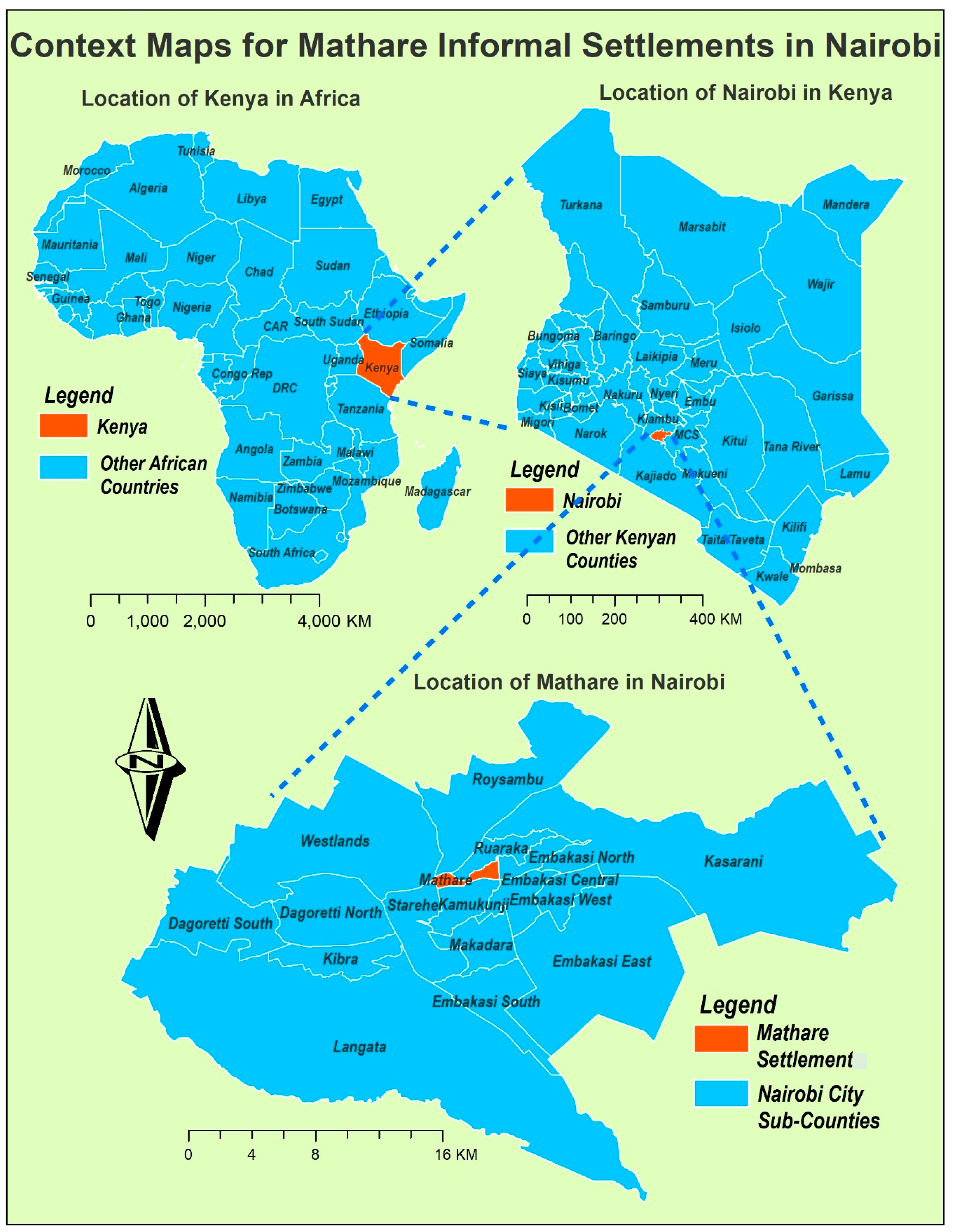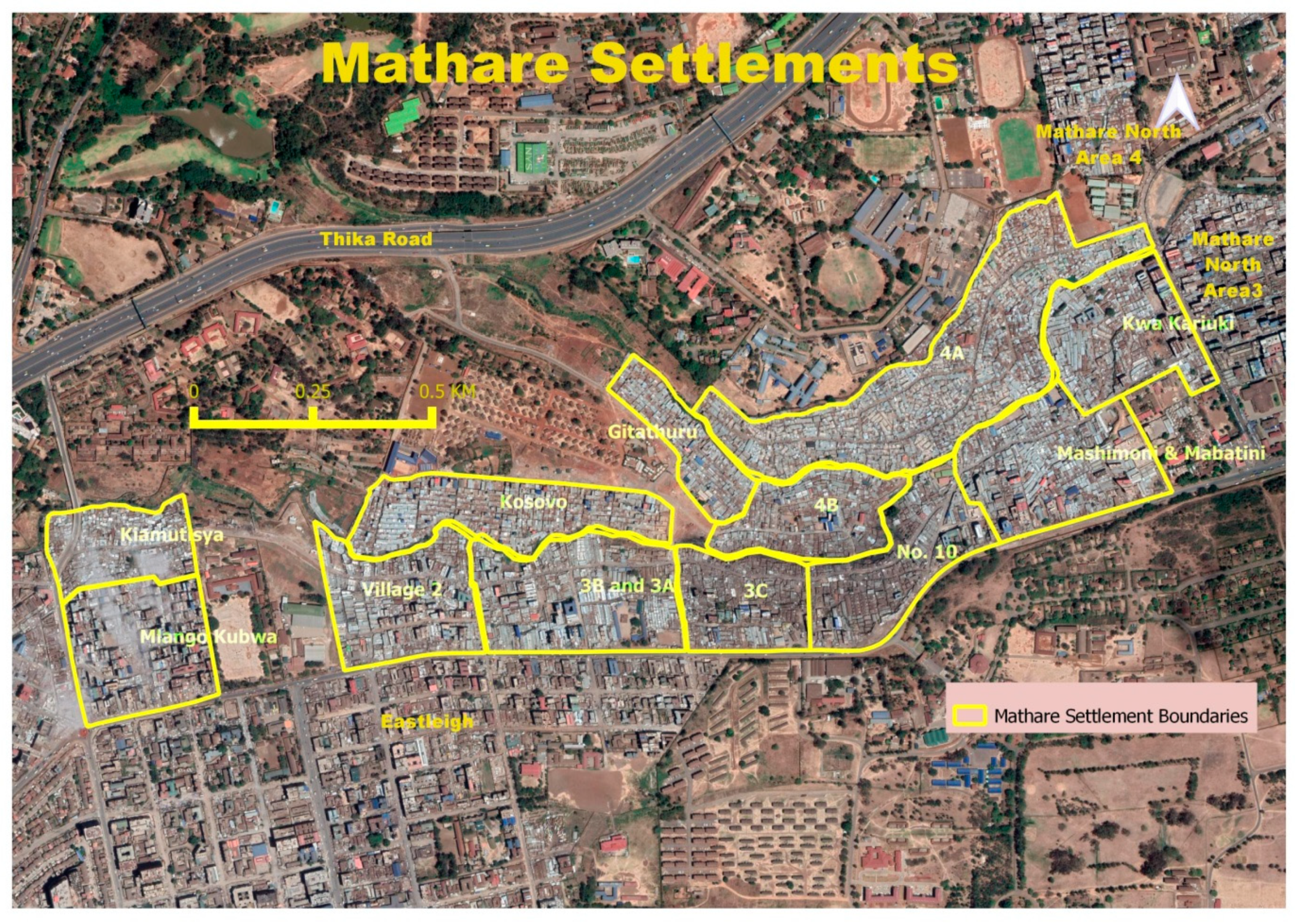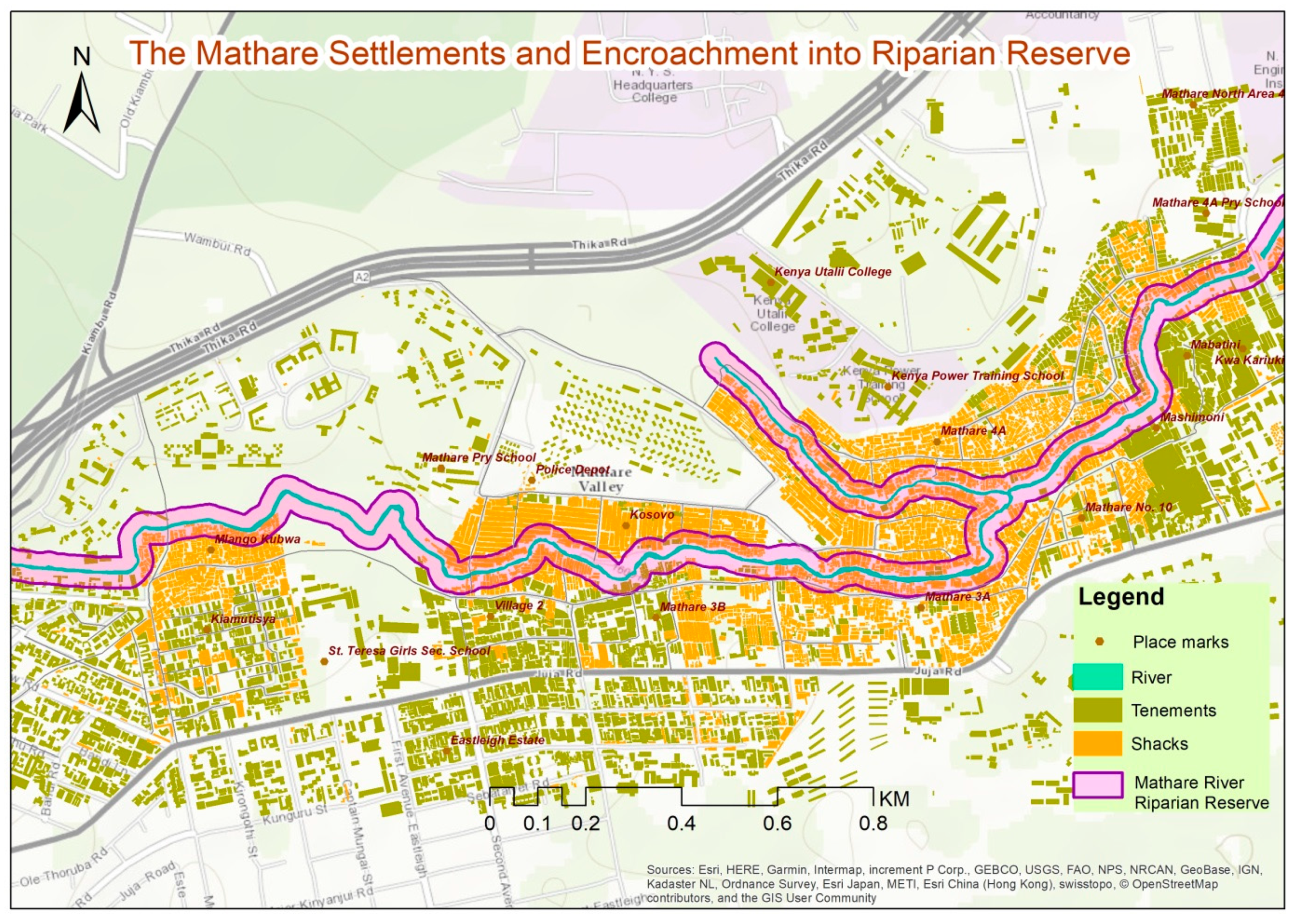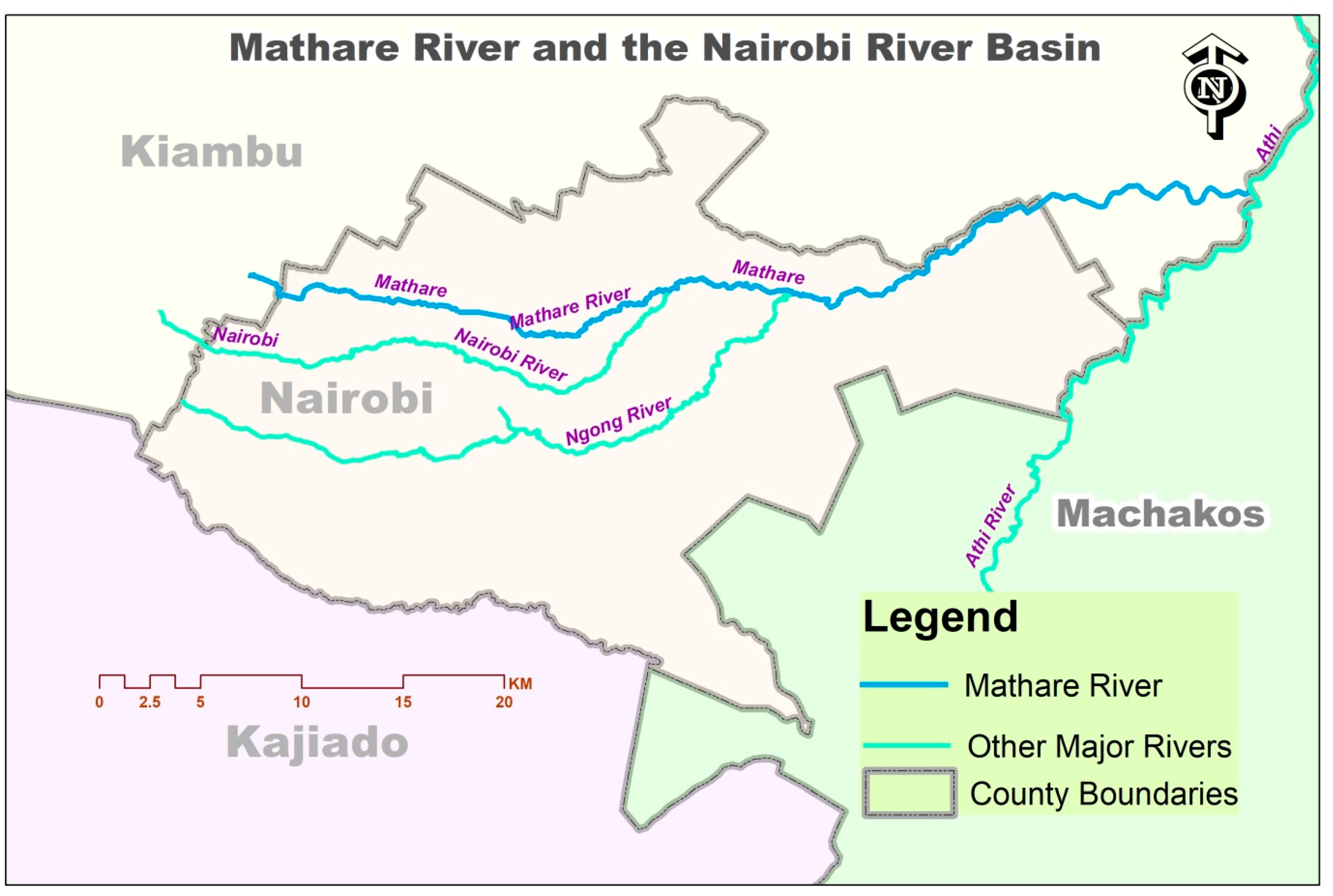Steering Energy Transitions through Landscape Governance: Case of Mathare Informal Settlement, Nairobi, Kenya
Abstract
:1. Introduction
Case Study: Mathare Informal Settlement
2. Material and Methods
3. Results
3.1. Findings from The Two-Year CoDEC Energy Project (2017–2019)
3.1.1. Energy Scenario and Challenges to Sustainable Energy Transition
3.1.2. Land Issues
3.1.3. Livelihood Issues
3.2. Findings from The Follow-Up Expert Interviews under AfriCLP Program (2019)
3.2.1. Lack of Consensus
3.2.2. Mistrust between Residents and Government Actors
3.2.3. Cultural, Social, and Economic Barriers
3.2.4. Lack of Awareness at the Sector and Community Levels
4. Analysis of CoDEC and AfriCLP Results through a Landscape Governance Framework
4.1. Ecological Dimension
4.2. Socio-Cultural Dimension
4.3. Political Dimension
4.4. Environmental Dimension
5. Discussion
5.1. Landscape and Energy Policy Interventions
5.2. Failure of Standardised Policy Interventions
5.3. Academics as Intermediaries of Change and Knowledge Co-Creation
5.4. Recommendations
5.5. Limitations
6. Conclusions
Author Contributions
Funding
Conflicts of Interest
References
- Turley, L. The Landscape Approach: Moving Towards Sustainable Land Use Patterns. SSI Commentary, Report, Ottawa. 2016. Available online: https://www.iisd.org/ssi/wp-content/uploads/2019/09/Landscape-Approach.pdf (accessed on 7 January 2020).
- Hofstad, H.; Tveit, S.; Stokke, B. Between development and protection: Different discourses in urban planning. Landsc. Res. 2014, 1–15. [Google Scholar] [CrossRef]
- Brandon, K. Learning Labs: Creating Collaborative Ways to Address Climate Change in African Cities. Stockholm Environment Institute. Available online: https://www.sei.org/featured/learning-labs-creating-collaborative-ways-to-address-climate-change-in-african-cities/ (accessed on 1 March 2020).
- Government of Kenya. Kenya Vision 2030. 2007. Available online: https://kfcb.co.ke/wp-content/uploads/2016/08/vision_2030.pdf (accessed on 9 April 2020).
- UN Habitat. The challenge of slums: Global report on human settlements 2003. Manag. Environ. Qual. 2004, 15, 337–338. [Google Scholar] [CrossRef]
- UNFPA. The State of the World Population 2018; United Nations Publisher: New York, NY, USA, 2018. [Google Scholar]
- United Nations. World Urbanization Prospects; United Nations Publisher: New York, NY, USA, 2014. [Google Scholar]
- Dodman, D.; Archer, D.; Mayr, M.; Engindeniz, E. Addressing the Most Vulnerable First: Pro-Poor Climate Action in Informal Settlements; UN-Habitat: Nairobi, Kenya, 2018; Available online: https://reliefweb.int/sites/reliefweb.int/files/resources/Pro-poor%20Climate%20Action%20in%20Informal%20Settlements%20-%20WEB.pdf (accessed on 27 December 2019).
- Habitat UN. Slum Almanac 2015–2016: Tracking Improvement in the Lives of Slum Dwellers. Participatory Slum Upgrading Programme. 2016. Available online: https://unhabitat.org/slum-almanac-2015-2016 (accessed on 20 February 2020).
- van Breda, J.; Swilling, M. The guiding logics and principles for designing emergent transdisciplinary research processes: Learning experiences and reflections from a transdisciplinary urban case study in Enkanini informal settlement, South Africa. Sustain. Sci. 2018, 14, 823–841. [Google Scholar] [CrossRef] [Green Version]
- Williams, S.; Costa, M.M.; Sutherland, C.; Celliers, L.; Scheffran, J. Vulnerability of informal settlements in the context of rapid urbanization and climate change. Environ. Urban. 2019, 31, 157–176. [Google Scholar] [CrossRef] [Green Version]
- Bai, X.; McPhearson, T.; Cleugh, H.; Nagendra, H.; Tong, X.; Zhu, T.; Zhu, Y.G. Linking urbanization and the environment: Conceptual and empirical advances. Annu. Rev. Environ. Resour. 2017, 42, 215–240. [Google Scholar] [CrossRef] [Green Version]
- WWF. WWF Living Forests Report: Chapter 2. Forests and Energy. 2011. Available online: https://wwf.panda.org/our_work/forests/forest_publications_news_and_reports/living_forests_report/energy_forests/ (accessed on 5 March 2020).
- Heiner, K.; Shames, S.; Spiegel, E. Integrated landscape management in Kenya: The state of the policy environment. In Proceedings of the 2016 World Bank conference on Land and Poverty, Washington, DC, USA, 14–18 March 2016. [Google Scholar]
- Mansourian, S.; Walters, G.; Gonzales, E. Identifying governance problems and solutions for forest landscape restoration in protected area landscapes. PARKS 2019, 83–96. [Google Scholar] [CrossRef]
- UNDP. Sustainable Energy. Available online: https://www.undp.org/content/undp/en/home/2030-agenda-for-sustainable-development/planet/sustainable-energy.html (accessed on 14 December 2019).
- Kovacic, Z.; Musango, J.; Ambole, L.; Buyana, K.; Smit, S.; Anditi, C.; Mwau, B.; Ogot, M.; Lwasa, S.; Brent, A.C.; et al. Interrogating differences: A comparative analysis of Africa’s informal settlements. World Dev. 2019, 122, 614–627. [Google Scholar] [CrossRef]
- Ambole, A.; Musango, J.; Buyana, K.; Ogot, M.; Anditi, C.; Mwau, B.; Kovacic, Z.; Smit, S.; Lwasa, S.; Nsangi, G.; et al. Mediating household energy transitions through co-design in urban Kenya, Uganda and South Africa. Energy Res. Soc. Sci. 2019, 55, 208–217. [Google Scholar] [CrossRef]
- Ambole, A.; Njoroge, P.; Outa, G.; Anditi, C. A case for providing electricity subsidies in urban informal settlements in Nairobi. KY Policy Briefs Realis. Vis. 2030 2020, 1, 21–22. Available online: https://uonresearch.org/journal/index.php/kpb/article/view/10/10 (accessed on 27 April 2020).
- Cheseto, M. Challenges in Planning for Electricity Infrastructure in Informal Settlements: Case of Kosovo Village, Mathare Valley-Nairobi. Master’s Thesis, University of Nairobi, Nairobi, Kenya, 2013. [Google Scholar]
- Mandour, M. Sustainable informal housing by means of a better public space. Int. J. Arab Cult. Manag. Sustain. Dev. 2012, 2, 370. [Google Scholar] [CrossRef]
- Sarmiento, H.; Tilly, C. Governance lessons from urban informality. Polit. Gov. 2018, 6, 199. [Google Scholar] [CrossRef] [Green Version]
- Mwaniki, D.; Wamuchiru, E.; Mwai, B.; Opiyo, R.; Mwaniki, D. Urbanisation, informality, and housing challenges in Nairobi: A case of urban governance Failure. Cell 2015, 254, 917–960. [Google Scholar]
- Sayer, J.; Sunderland, T.; Ghazoul, J.; Pfund, J.; Sheil, D.; Meijaard, E.; Venter, M.; Boedhihartono, A.K.; Day, M.; Garcia, C.; et al. Ten principles for a landscape approach to reconciling agriculture, conservation, and other competing land uses. Proc. Natl. Acad. Sci. USA 2013, 110, 8349–8356. [Google Scholar] [CrossRef] [PubMed] [Green Version]
- Arts, B.; Buizer, M.; Horlings, L.; Ingram, V.; van Oosten, C.; Opdam, P. Landscape approaches: A state-of-the-art review. Annu. Rev. Environ. Resour. 2017, 42, 439–463. [Google Scholar] [CrossRef]
- Prieur, M.; Luginbühl, Y.; Zoido, N.F.; de Montmollin, B.; Pedroli, B.; van Mansvelt, J.D.; Durosseau, S. Landscape and Sustainable Development: Challenges of the European Landscape Convention; Council of Europe Publishing: Strasbourg, France, 2006. [Google Scholar]
- De Graaf, M.; Buck, L.; Shames, S.; Zagt, R. Assessing Landscape Governance: A Participatory Approach; Tropenbos International and EcoAgriculture Partners: Wageningen, The Netherlands, 2017. [Google Scholar]
- van Assche, K.; Beunen, R. Shifting forms of landscape governance: Environmental policy, spatial planning and place branding strategies. In Working Papers in Evolutionary Governance Theory; International Institute for Innovation in Governance: Wageningen, The Netherlands, 2017; pp. 1–21. Available online: https://d1wqtxts1xzle7.cloudfront.net/53420070/Shifting_forms_of_landscape_governance_Flanders.pdf?1496835825=&response-content-disposition=inline%3B+filename%3DShifting_forms_of_landscape_governance_e.pdf&Expires=1592410420&Signature=bVwdBkbqmL4sOoY9CZn~~xNpD0RTRI31hhCE~TULNd86fxD~Lg3EbS5JulJroo~WQhTdxgFRhGWMy8uvJ2kOsthT7fKp8Orw8WN3FM~p3rJT-uGFHMITZ8tpJcKlG0VDHnPC7K3fDJw8My0fHR8P6lhMrP8-nPjW6U9XorUMPe0k3eX3o2iD4ocZVJmPdY9S3uO-FBoChApWKBb77vK39WZsREdiv6hqpXNNWCXYHrVm9VfnJ8IsXIkBLs-VPZgQ3qvrjOQtGlkEhh3n2IX5vEdgViyG8KdDEi~q7WPYFA-pf-Btb2oYBHclH-F74vFbABuHvj3Pz-JVsirOKfa51A__&Key-Pair-Id=APKAJLOHF5GGSLRBV4ZA (accessed on 27 February 2020).
- Syagga, P.; Malombe, J. Development and Management of Informal Housing in Kenya (Draft Report); Housing and Building Research Institute: Nairobi, Kenya, 1994. [Google Scholar]
- Jones, P. Formalizing the informal: Understanding the position of informal settlements and slums in sustainable urbanization policies and strategies in Bandung, Indonesia. Sustainability 2017, 9, 1436. [Google Scholar] [CrossRef] [Green Version]
- Andvig, J.; Barasa, T. A Political Economy of Slum Spaces: Mathare Valley; Norwegian Institute of International Affairs: Oslo, Norway, 2014. [Google Scholar]
- Kenya National Bureau of Statistics. Kenya Population and Housing Census; Kenya National Bureau of Statistics: Nairobi, Kenya, 2019; Volume I.
- World Health Organization. Guidelines for Drinking Water Quality, Vol. 1, Recommendations, 4th ed.; World Health Organization: Geneva, Switzerland, 2011. [Google Scholar]
- Njuguna, S.; Yan, X.; Gituru, R.; Wang, Q.; Wang, J. Assessment of macrophyte, heavy metal, and nutrient concentrations in the water of the Nairobi river, Kenya. Environ. Monit. Assess. 2017, 189. [Google Scholar] [CrossRef] [PubMed] [Green Version]
- Mehnen, N.; Mose, I.; Strijker, D. Governance and sense of place: Half a century of a German nature park. Environ. Policy Gov. 2013, 23, 46–62. [Google Scholar] [CrossRef]
- Mwaniki, D. Mapping Pollution in the Mathare River: An Analysis of Waste Disposal Patterns and River Pollution in an Informal Settlement. Ph.D. Thesis, University of Nairobi, Nairobi, Kenya, 2012. [Google Scholar]
- Höppner, C.; Frick, J.; Buchecker, M. Assessing psycho-social effects of participatory landscape planning. Landsc. Urban Plan. 2007, 83, 196–207. [Google Scholar] [CrossRef]
- Conniff, A.; Colley, K.; Irvine, K. Exploring landscape engagement through a participatory touch table approach. Soc. Sci. 2017, 6, 118. [Google Scholar] [CrossRef] [Green Version]
- Ellis, E. Ecology in an anthropogenic biosphere. Ecol. Monogr. 2015, 85, 287–331. [Google Scholar] [CrossRef]
- Fuentes, A. Human niche, human behaviour, human nature. Interface Focus 2017, 7. [Google Scholar] [CrossRef] [PubMed]
- Van, C.; Seerp, W. Landscape Governance Capacity: Towards a Framework for Assessment and Strategic Guidance of Landscape Initiatives; Wageningen Centre for Development Innovation: Wageningen, The Netherlands, 2016. [Google Scholar]
- Zhous, Z. Towards collaborative approach? Investigating the regeneration of urban village in Guangzhou, China. Habitat Int. 2014, 44, 297–305. [Google Scholar] [CrossRef]
- Njenga, M. Banning Charcoal Isn’t the Way to Go. Kenya Should Make it Sustainable. The Conversation. 2018. Available online: https://theconversation.com/banning-charcoal-isnt-the-way-to-go-kenya-should-make-it-sustainable-95610 (accessed on 19 December 2019).
- Abdallah, H. Charcoal Traders Go to Uganda after Kenya Ban. The East African. 2019. Available online: https://www.theeastafrican.co.ke/business/Charcoal-traders-go-to-Uganda-after-Kenya-ban-/2560-5097292-lj12s4z/index.html (accessed on 20 December 2019).
- Sovacool, B. The political economy of energy poverty: A review of key challenges. Energy Sustain. Dev. 2012, 16, 272–282. [Google Scholar] [CrossRef]
- Kaygusuz, K. Energy for sustainable development: A case of developing countries. Renew. Sustain. Energy Rev. 2012, 16, 1116–1126. [Google Scholar] [CrossRef]
- Horlings, L.; Battaglini, E.; Dessein, J. Cultural Sustainability and Regional Development. In Theories and Practices of Territorialisation, 1st ed.; Dessein, J., Battaglini, E., Horlings, L., Eds.; Routledge: London, UK, 2016; pp. 1–6. [Google Scholar]
- Schatzki, T. The site of the social: A philosophical account of the constitution of social life and change. Choice Rev. Online 2003, 40, 3940–3946. [Google Scholar] [CrossRef]
- van Assche, K.; Beunen, R.; Duineveld, M. Citizens, leaders and the common good in a world of necessity and scarcity: Machiavelli’s lessons for community-based natural resource management. Ethics Policy Environ. 2016, 19, 19–36. [Google Scholar] [CrossRef]
- Leibenath, M.; Lintz, G. Governance of energy landscapes between pathways, people and politics. Landsc. Res. 2018, 43, 471–475. [Google Scholar] [CrossRef] [Green Version]
- Carvalho, A.; van Wessel, M.; Maeseele, P. Communication practices and political engagement with climate change: A research agenda. Environ. Commun. 2016, 11, 122–135. [Google Scholar] [CrossRef]
- Sayer, J.; Margules, C.; Boedhihartono, A.; Dale, A.; Sunderland, T.; Supriatna, J.; Saryanthi, R. Landscape approaches; what are the pre-conditions for success? Sustain. Sci. 2014, 10, 345–355. [Google Scholar] [CrossRef]
- The East African. Picking a Pathway through the Disappearing Forests of Kenya. 2018. Available online: https://www.theeastafrican.co.ke/scienceandhealth/Picking-a-pathway-through-the-disappearing-forests-of-Kenya-/3073694-4351716-rre74/index.html (accessed on 14 December 2019).
- Natural Resources Alliance of Kenya. Kenya’s Forest Cover. 2017. Available online: https://kenra.or.ke/kenyas-forest-cover-2/ (accessed on 19 December 2019).
- Asikainen, S.; Brites, C.; Plebańczyk, K.; Mijatović, L.; Soini, K. Culture in Sustainability: Towards a Transdisciplinary Approach; SoPhi: Jyväskylä, Finland, 2017. [Google Scholar]
- Horlings, L.G. The Role of Artists and Researchers in Sustainable Place-Shaping. In Culture in Sustainability: Towards a Transdisciplinary Approach; Asikainen, S., Brites, C., Plebańczyk, K., Mijatović, L.R., Soini, K., Eds.; SoPhi: Jyväskylä, Finland, 2017; pp. 131–143. [Google Scholar]
- van Oosten, C. Forest landscape restoration: Who decides? A governance approach to forest landscape restoration. Nat. Conserv. 2013, 11, 119–126. [Google Scholar] [CrossRef]
- Nadaï, A.; van der Horst, D. Introduction: Landscapes of energies. Landsc. Res. 2010, 35, 143–155. [Google Scholar] [CrossRef] [Green Version]
- Butera, F.M.; Adhikari, R.S.; Caputo, P.; Facchini, A. The Challenge of Energy in Informal Settlements. A Review of the Literature for Latin America and Africa; Enel Foundation: Rome, Italy, 2015. [Google Scholar]
- Fernandes, E. Regularization of Informal Settlements in Latin America; Lincoln Institute of Land Policy: Cambridge, UK, 2011. [Google Scholar]
- Chepkwony, J. Charcoal Trade Thrives Despite Logging Ban: The Standard. 2019. Available online: https://www.standardmedia.co.ke/article/2001309788/charcoal-trade-thrives-despite-logging-ban (accessed on 20 December 2019).
- Mansourian, S.; Sgard, A. Diverse interpretations of governance and their relevance to forest landscape restoration. Land Use Policy 2019, 1–8. [Google Scholar] [CrossRef]
- Ferranti, F.; Turnhout, E.; Beunen, R.; Behagel, H. Shifting nature conservation approaches in Natura 2000 and the implications for the roles of stakeholders. J. Environ. Plan. Manag. 2014, 57, 1642–1657. [Google Scholar] [CrossRef]
- Newig, J.; Fritsch, O. Environmental governance: Participatory, multi-level–and effective? Environ. Policy Gov. 2009, 19, 197–214. [Google Scholar] [CrossRef] [Green Version]
- Beunen, R.; Opdam, P. When landscape planning becomes landscape governance, what happens to the science? Landsc. Urban Plan. 2011, 100, 324–326. [Google Scholar] [CrossRef]
- Angelstam, P.; Munoz-Rojas, J.; Pinto-Correia, T. Landscape concepts and approaches foster learning about ecosystem services. Landsc. Ecol. 2019, 34, 1445–1460. [Google Scholar] [CrossRef] [Green Version]
- Freeman, O.; Duguma, L.; Minang, P. Operationalizing the integrated landscape approach in practice. Ecol. Soc. 2015, 20. [Google Scholar] [CrossRef] [Green Version]
- Reed, J.; van Vianen, J.; Barlow, J.; Sunderland, T. Have integrated landscape approaches reconciled societal and environmental issues in the tropics? Land Use Policy 2017, 63, 481–492. [Google Scholar] [CrossRef]
- Sulistyawan, B.; Feger, C.; McKenzie, E.; Gallagher, L.; Verweij, P.; Verburg, R. Towards more effective landscape governance for sustainability: The case of RIMBA corridor, Central Sumatra, Indonesia. Sustain. Sci. 2019, 14, 1485–1502. [Google Scholar] [CrossRef] [Green Version]
- Zoellner, J.; Schweizer-Ries, P.; Wemheuer, C. Public acceptance of renewable energies: Results from case studies in Germany. Energy Policy. 2008, 36, 4136–4141. [Google Scholar] [CrossRef]
- Public Policy for Integrated Landscape Management in Kenya: Executive Summary of the Report from the National Dialogue. 24–26 June 2014. Available online: http://worldagroforestry.org/sites/default/files/Public%20Policy%20Dialogue%20for%20Integrated%20Landscape%20Management%20in%20Kenya.pdf (accessed on 1 March 2020).
- Broto, V.C. Energy landscapes and urban trajectories towards sustainability. Energy Policy 2017, 108, 755–764. [Google Scholar] [CrossRef]
| 1 |




| Initiative | Places Where Implemented | What Worked | What Has Not Worked | Viability in Mathare |
|---|---|---|---|---|
| Universal electrification | Enkanini (Solar project) Mathare (Biogas project) | Improved safety through street lighting | Failed to significantly curb the use of charcoal and paraffin | Biogas project failed |
| Pre-paid electricity system | South Africa; Kenya | Consumers are able to access clean energy within their budget | The system could be limiting for people of low income | The pre-paid system failed in Mathare because it cost residents more than what they pay for the illegal connection |
| Recycling for electricity credit | Chile, Brazil | Dumping is reduced through recycling. It eases the expenses of paying for electricity | Could be considered as a long-term project to reduce the menace of illegal dumping along the roads and banks of Mathare River. | |
| Slum regeneration and recognition projects | Peru, Brazil, China, Indonesia | Titling has given informal settlements land ownership that allows them to develop their landscapes and have a sense of identity and belonging. Regeneration projects have allowed upgrading of houses in the informal settlements to allow better provision of services and essential amenities | Regeneration projects have led to demolition of structures during the upgrade and thus failed to secure housing for all residents as some had to move to other peri-urban areas [30]. | Titling allows residents to have legal ownership and documentation required by the utility provider to provide access to the grid. This is a potential solution to Mathare’s energy issues. |
© 2020 by the authors. Licensee MDPI, Basel, Switzerland. This article is an open access article distributed under the terms and conditions of the Creative Commons Attribution (CC BY) license (http://creativecommons.org/licenses/by/4.0/).
Share and Cite
Njoroge, P.; Ambole, A.; Githira, D.; Outa, G. Steering Energy Transitions through Landscape Governance: Case of Mathare Informal Settlement, Nairobi, Kenya. Land 2020, 9, 206. https://doi.org/10.3390/land9060206
Njoroge P, Ambole A, Githira D, Outa G. Steering Energy Transitions through Landscape Governance: Case of Mathare Informal Settlement, Nairobi, Kenya. Land. 2020; 9(6):206. https://doi.org/10.3390/land9060206
Chicago/Turabian StyleNjoroge, Peris, Amollo Ambole, Daniel Githira, and George Outa. 2020. "Steering Energy Transitions through Landscape Governance: Case of Mathare Informal Settlement, Nairobi, Kenya" Land 9, no. 6: 206. https://doi.org/10.3390/land9060206




